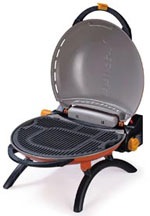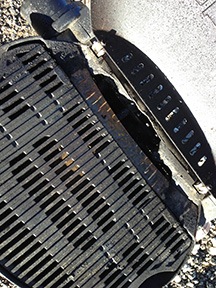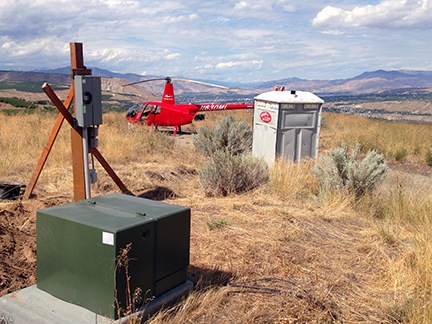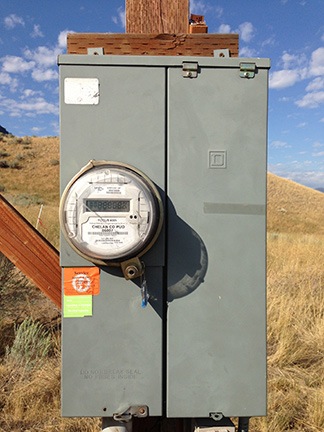Literally.*
Last week, I blogged about cleaning my hand-me-down temporary power box in preparation for rewiring it and installing it on my 10-acre lot in Malaga, WA. At the end of that post, I mentioned that I hoped my friend and I could have it in place later that day.
Well, I got what I hoped for. When my friend rolled up just minutes after publishing that post to this blog, he was eager to get started on the job. By the end of the day, the pole was in place.
Rewiring

Here’s what we started with.
The first job was clearing out the old wires to replace them with new ones. Not everything had to go. We had to remove the wires on the left side of the box and replace them with a new set that I’d bought the previous week. On the right side, we had to connect wires to the 30 amp breaker and run those wires down to an RV outlet that had to be positioned farther down the pole.
I backed my pickup down to where the pole was and we lifted it into the back of my truck with the business end on the tailgate. Then I moved the truck forward into the shade of the house under construction — now nearly finished — where I’m currently living. I fetched all the pieces I’d bought at Home Depot and the electrical supply shop the week before and got out some tools.
I think my friend was pretty surprised when he realized that I knew how to use tools. Apparently, a lot of women don’t. When he pointed out which wires needed to be removed, I grabbed the right screwdriver and got to work on it. After all, I was supposed to do all the wiring myself — that was a requirement of my permit. (In Chelan County, either the homeowner hires a licensed electrician to do all the work or does it all herself. The rule didn’t say anything about coaching from a knowledgable friend.)
I had most of the tools needed to get the job done. There were only two I didn’t have — and got the next time I was out: a good wire stripper and a hacksaw. The wire stripper was needed for obvious reasons — each new wire’s end had to be stripped before it could be fastened into place. The hacksaw was to cut the plastic conduit that also needed to be replaced.
Step-by-step we worked our way through the box. I learned about how the box was organized and what each wire did. It was surprisingly simple. And safe — it wasn’t hooked up to any power yet.
Then we were finished. It had taken less than an hour.
Planting the Pole
We closed up the tailgate, climbed into the truck, and headed out. I think my friend was more excited about getting the pole set up than I was. Don’t get me wrong — I was eager to get it set up. But when you consider that he had plenty of other things to do that day, it was really nice — and so refreshing! — to be with someone who was so focused on helping me get a job done. (That’s part of what real friends are all about.)
At my property, my friend was pleasantly surprised at the trench and hole I’d dug. After seeing me limp around on a bad foot for three weeks, I don’t think he had very high expectations. I think he’d come with the idea that he’d have to do some digging, despite the fact that I’d assured him that I’d dug the trench to specs. He later told me that out of everything I’d done so far on this project, digging that trench was the most impressive. (I have to agree. I surprised myself.)
Because he’s a man, though, he had to pick up a shovel and extend the trench a little in front of the transformer box. I’m not sure if he did it because he thought we needed the extra length or if he was trying to see for himself how difficult it was to dig. If the later, he discovered that it was quite easy to dig. After all, a middle-aged woman with a gimpy foot had done it.
I backed the truck up as close to the post hole as I could and we wrestled the pole out of the truck and into the hole. It was a bit of a struggle, mostly because of the conduit hanging loose with a 90° angle at the bottom and 10 feet of wire hanging out. But we finally got it into place. We threw some rocks into the hole and followed that up with some dirt. We realized that the fastener we’d brought to connect the grounding wire to the grounding rod wasn’t big enough. I’d have to come back and make that connection another time.

My friend took this silly photo of me with the power pole and box installed.
The last step was putting in the two required supporting poles each in a different direction. We used the same poles my friend had used for his setup. The heads on the screws he’d used stripped immediately, but I had some long nails in my toolbox to get the job done.
My friend voiced some concern about the grounding rod being inside the hole. He seemed to think it needed to be driven in from the surrounding grade to make it more sturdy. But it was sturdy. If I could have pulled it out, I would have — just to drive it in elsewhere. It would have to wait. I could aways get another rod if I needed to.
Finished, my friend took a picture of me by the pole. Then we put away the shovel and other tools and celebrated by going out for a late Thai lunch in town.
I called the Chelan County PUD and told them the power pole was ready for inspection. I knew it would be at least 24 hours before the inspector came out.
Fastening the Grounding Wire
Later that day, while doing laundry at a local laundromat, I stopped at a hardware store to pick up the piece I’d need to connect the grounding wire to the rod. But rather than take care of it that day, I went out to dinner with another friend. We spent the evening back at the Mobile Mansion where we chatted and drank wine and I helped him fix a problem he was having with his GPS. (Once a techie, always a techie.)
The next day, I had a charter flight down to Othello and Pasco. I had to pick up my passengers at 8 AM sharp. Before leaving, however, I put the grounding rod connector piece and a screwdriver in my bag.

Heck, why make the drive when I was only a few minutes away by air?
At about 1 PM, when the flight was done and I’d dropped off my passengers, I flew over to the property and landed at the end of the driveway. I shut down and took the connector and screwdriver over to the power pole.
 I sure did drive that rod in close to the pole.
I sure did drive that rod in close to the pole.
I ran the connector through the very long piece of copper wire and made the connection to the rod. My friend had told me I could bury the extra wire. Seemed like a shame to me, but I really didn’t care. All I wanted was to pass the inspection.
The Inspection
I was home for less than an hour when the phone rang. It was the inspector. He said he’d be out on the property by 3 PM.
Thinking that showing up in a helicopter would be a wee bit too cocky, I jumped into my Jeep and made the 30-minute drive from Wenatchee Heights to Malaga. I had to stop for gas, of course — why is it that my vehicles always need fuel when I’m in a hurry? But even though I arrived early, the inspector was already there, looking at my pole and the trench and the hole.
Penny and I hopped out of the Jeep and I extended my hand as I walked up to the inspector. “What do you think of my trench?” I asked proudly. “I dug it myself.”
We both laughed.
He did the inspection, pointing out the few minor things that were wrong with the setup. Because they were minor, however, he let the pole pass inspection. He put the official sticker on the box.
Another hurdle jumped.
I’ve Got the Power
That was on Tuesday. Part of the inspector’s job is to call the Chelan County PUD and arrange for them to hook up the power. I had no idea if I needed to be present, but I figured that they had my phone number and would call if they needed me.
The rest of the week rolled by. I got busy. (I always get busy.) I didn’t hear anything about the power pole.
On Saturday, I had a charter flight. I was taking a couple up to Tsillan Cellars in Chelan for dinner. I had to meet them at the airport at 4 PM. But it was a nice day and I felt like flying. So I fired up the helicopter and took it out for a spin in the Leavenworth area where some friends of mine were hiking in the mountains. One of them had texted me his general location with some landmarks. I thought it would be fun to try to spot them from the air. And I hooked up the GoPro to get some video while I was out. (More of that in another post.)
By 3 PM I was ready to head back to Wenatchee. I needed fuel and wanted to relax for a while before meeting my passengers. I figured I’d fly by my property to see whether I could tell if the power had been installed.

The meter on my power box confirmed that power was available at my lot.
I didn’t want to land there and shut down, but I did have to get close. I hovered near the transformer box. The wires I’d left loose were buried. As I flew away leaving a nasty cloud of dust (from the digging) behind me, I realized that I now had both water and power on the property.
I confirmed that the power worked just yesterday when I drove out to take a look. There was a meter on the box and it was running. I took a shovel and finished filling in the hole and ditch.
I was another step closer to my new home.
[*Note: Thanks to my old friend Steve for inspiring the title of this blog post.]
 The Iroda O-Grill.
The Iroda O-Grill.

 My new O-Grill looks a lot like my old one, but it’s red instead of orange.
My new O-Grill looks a lot like my old one, but it’s red instead of orange.





 I sure did drive that rod in close to the pole.
I sure did drive that rod in close to the pole.